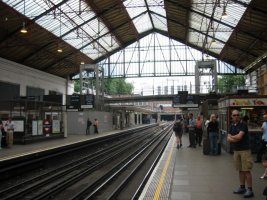
R142 6415 at East Tremont Avenue, June 20, 2009
In keeping with the recent post about a podcast episode recommendation, here comes another one that may be worth your time. This time, we’re featuring the “Mind the Gap” episode from “Twenty Thousand Hertz“, which describes itself as “the stories behind the world’s most recognizable and interesting sounds.” If the episode’s title immediately conjures an image of the London Underground in your head, I think it is fair to say this podcast is achieving its goal.
This episode features the stories of the voices behind the iconic subway announcements in London by Elinor Hamilton and in New York City by Charlie Pellett and even though I had some familiarity with some aspects of their stories, there were also some parts of their careers and stories I was not familiar with, especially Elinor Hamilton’s. If you’re really into the automated, prerecorded announcements that are commonplace on public transit today, you’ll want to give this a listen. (Even Mrs. Oren’s Transit Page, who is not the biggest podcast fan, enjoyed listening to this one with me.)
Listen to Twenty Thousand Hertz’s “Mind the Gap” episode (or read the transcript) by clicking here, or searching wherever you prefer to download your podcasts.
Oren’s Reading List is an occasional feature on The Travelogue in which I share articles that I’ve read that might also be of interest to the readers of this website.
 1992 Tube Stock 91155
1992 Tube Stock 91155 1973 Stock 126
1973 Stock 126 1996 Tube Stock 96076
1996 Tube Stock 96076
 Planning a trip to London? Perhaps you are traveling to ride the
Planning a trip to London? Perhaps you are traveling to ride the 





